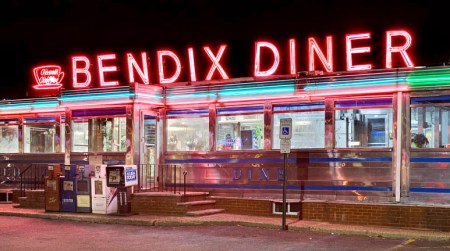Today’s Zippy:
The strip uses the V P idiom name(d) after, but that made me think about the noun namesake.
First, the diner:
Bendix Diner [with its Art Deco style and neon signage] is located between Route 17 North and Route 17 South near the intersection of Route 17 and Williams Avenue [in Hasbrouck Heights NJ]. One of the original Jersey diners [founded and built by Charles “Chip” De Lorenzo Sr.], it has been in business since 1938 .
Inside there are several large booths, tables and about 20 stools at the counter. The restaurant offers a full menu of diner fare — options include burgers, salads, appetizers, chicken, steak, meatloaf, seafood, hot and cold sandwiches, Greek specialties, Italian specialties, omelettes, waffles, muffins, French toast, pancakes, eggs, fruit, pastries, pies, pudding, cakes and ice cream. (link)
At night, all lit up:
And inside:
The semantics of the verb idiom name X (N) after Y requires that Y have the name N first and that X is then given N in recognition of Y: my parents named [active PST V] me (Arnold) after my father (also Arnold), I was named [passive V] (Arnold) after my father, I am named [Adj use of PSP V] Arnold after my father.
The noun namesake works differently: in
(1) X is Y‘s namesake
and (2) X is the namesake of Y
all that’s required is that X and Y have the same name, N. NOAD2: ‘a person or thing that has the same name as another’. This relational noun is symmetrical: if X is Y’s namesake, then Y is X’s namesake; that is, there’s no necessary temporal relationship in naming. In principle, the name-sharing doesn’t have to be the result of someone’s bestowing the name on one of these in recognition of the other, though that’s often the case; nevertheless, there are accidental namesakes, like the Japanese town named Obama and the U.S. President Barack Obama (a relationship that apparently delighted the Japanese town).
It does look like (1) and (2) are often used when X is in fact named after Y, as in NOAD2’s example:
Hugh Capet paved the way for his son and namesake to be crowned king of France.
Here, Hugh Capet’s namesake was named after him. But the examples in OED3 (June 2003) include one in which X comes after Y, but without necessarily a recognition of Y in the naming of X:
1867 E. A. Freeman Hist. Norman Conquest I. iv. 206 The unhappy descendant and namesake of the great Emperor.
and several in which Y is named after X rather than the reverse:
1902 ‘O. Henry’ in Ainslee’s Mag. Feb. 126/1 Chicken’s heart was as soft as those of his feathered namesakes. [the birds are Chicken’s namesakes; X comes before Y, and Y was probably named after X]
1987 A. Nickon & E. F. Silversmith Org. Chem.: Name Game xix. 267 Ockham’s Razor (like its steel namesake) must be wielded cautiously. [the steel razor is Ockham Razor’s namesake; X comes before Y, and Y was certainly named after X]
2000 Guardian (Dar-es-Salaam) 27 Mar. 18/1 The Speakers’ Corner, inspired by its namesake in London’s Hyde Park..is intended to bring citizens out of..private venues. [Speakers’ Corner in Hyde Park is the namesake of the one in Tanzania; X comes before Y, and Y was named after it]



July 18, 2013 at 8:57 am |
This is news to me. I had thought that the original (and what I thought of as the “true”) meaning of “namesake” was “one named after”; in other words, you could be your father’s namesake, but he could not be yours — this despite hearing and reading the other use often enough.
Also: What about the element “sake”? I can’t think of another word in which it’s used similarly.